Chapter 20
Organic and Chemistry
Shaun Williams, PhD
Organic Chemistry and Biochemistry
- Organic Chemistry
- The study of carbon-containing compounds and their properties. The vast majority of organic compounds contain chains or rings of carbon atoms.
- Biochemistry
- The study of the chemistry of living things.
Hydrocarbons
- Compounds composed of carbon and hydrogen.
- Saturated: C—C bonds are all single bonds.
- Unsaturated: contains carbon–carbon multiple bonds.
$$ \text{alkanes } \chem{[C_nH_{2n+2}]} $$



Isomerism in Alkanes
- Structural isomerism – occurs when two molecules have the same atoms but different bonds.
- Butane and all succeeding members of the alkanes exhibit structural isomerism.
Butane
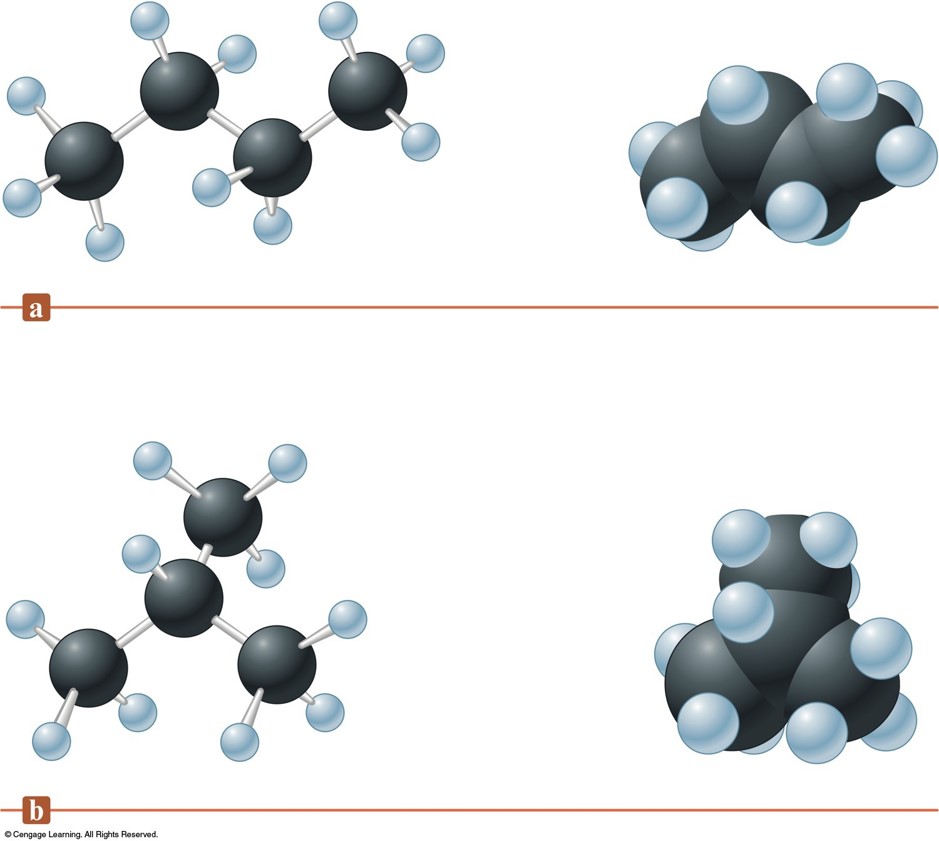
Rules for Naming Alkanes
- For alkanes beyond butane, add –ane to the Greek root for the number of carbons.
- Alkyl substituents: drop the –ane and add –yl.
- Positions of substituent groups are specified by numbering the longest chain sequentially. The numbering is such that substituents are at lowest possible number along chain.
$$ \chem{CH_3–CH_2–CH_2–CH_2–CH_2–CH_3} = \text{hexane} $$
$$ \chem{C_2H_6}\text{ is ethane} $$
$$ \chem{C_2H_5}\text{ is ethyl} $$
$$ \begin{align} &\chem{CH_3} \\ &\,| \\ \chem{CH_3-CH_2-} &\chem{CH-CH_2-CH_2-CH_3} \end{align} $$
3-methylhexane
Rules for Naming Alkanes Continued
- Location and name are followed by root alkane name. Substituents in alphabetical order and use di–, tri–, etc.
$$ \begin{align} &\chem{\underset{|}{C}H_3\phantom{-}\underset{|}{C}H_3}\\ \chem{CH_3-CH_2-} &\chem{CH-CH-CH_2-CH_3} \\ \end{align} $$
3,4-dimethylhexane
Selected Properties of the First Ten Normal Alkanes
| Name | Formula | Molar Mass | Melting Point (\({}^\circ\mathrm{C}\)) |
Boiling Point (\({}^\circ\mathrm{C}\)) |
Number of Structural Isomers |
|---|---|---|---|---|---|
| Methane | \(\chem{CH_4}\) | 16 | -182 | -162 | 1 |
| Ethane | \(\chem{C_2H_6}\) | 30 | -183 | -89 | 1 |
| Propane | \(\chem{C_3H_8}\) | 44 | -187 | -42 | 1 |
| Butane | \(\chem{C_4H_{10}}\) | 58 | -138 | 0 | 2 |
| Pentane | \(\chem{C_5H_{12}}\) | 72 | -130 | 36 | 3 |
| Hexane | \(\chem{C_6H_{14}}\) | 86 | -95 | 68 | 5 |
| Heptane | \(\chem{C_7H_{16}}\) | 100 | -91 | 98 | 9 |
| Octane | \(\chem{C_8H_{18}}\) | 114 | -57 | 126 | 18 |
| Nonane | \(\chem{C_9H_{20}}\) | 128 | -54 | 151 | 35 |
| Decane | \(\chem{C_{10}H_{22}}\) | 142 | -30 | 174 | 75 |
The Most Common Alkyl Substituents and Their Names
| Structure | Name | Structure | Name |
|---|---|---|---|
| \(\chem{-CH_3}\) | Methyl | \(\begin{align} &\chem{CH_3} \\ &\,| \\ \chem{-} &\chem{C-CH_3} \\ &\,| \\ &\chem{CH_3} \end{align}\) | tert-Butyl |
| \(\chem{-CH_2CH_3}\) | Ethyl | ||
| \(\chem{-CH_2CH_2CH_3}\) | Propyl | ||
| \(\chem{CH_3\overset{|}{C}HCH_3}\) | Isopropyl | ||
| \(\chem{-CH_2CH_2CH_2CH_3}\) | Butyl | ||
| \(\chem{CH_3\overset{|}{C}HCH_2CH_3}\) | sec-Butyl | ||
| \(\begin{align} &\chem{H} \\ &\,| \\ \chem{-CH_2-} &\chem{C-CH_3} \\ &\,| \\ &\chem{CH_3} \end{align}\) | Isobutyl |
Exercise
Name each of the following:
2,2,4,5-tetramethylhexane
3,6-diethyl-3-methyloctane
Combustion Reactions of Alkanes
- At a high temperature, alkanes react vigorously and exothermically with oxygen.
- Basis for use as fuels.
$$ \chem{2C_4H_{10}(g) + 13O_2(g) \rightarrow 8CO_2(g) + 10 H_2O(g)} $$
Substitution Reactions of Alkanes
- Primarily where halogen atoms replace hydrogen atoms. $$ \begin{align} &\chem{CH_4 + Cl_2 \xrightarrow{h\nu} CH_3Cl + HCl} \\ &\chem{CH_3Cl + Cl_2 \xrightarrow{h\nu} CH_2Cl_2 + HCl} \\ &\chem{CH_2Cl_2 + Cl_2 \xrightarrow{h\nu} CHCl_3 + HCl} \\ &\chem{CHCl_3 + Cl_2 \xrightarrow{h\nu} CCl_4 + HCl} \end{align} $$
Dehydrogenation Reactions of Alkanes
- Hydrogen atoms are removed and the product is an unsaturated hydrocarbon. $$ \chem{CH_3CH_3 \xrightarrow[500^\circ C]{Cr_2O_3} \underset{Ethylene}{CH_2=CH_2} + H_2} $$
Cyclic Alkanes
- Carbon atoms can form rings containing only C-C single bonds.
- General formula: \(\chem{C_nH_{2n}}\)
The Chair and Boat Forms of Cyclohexane
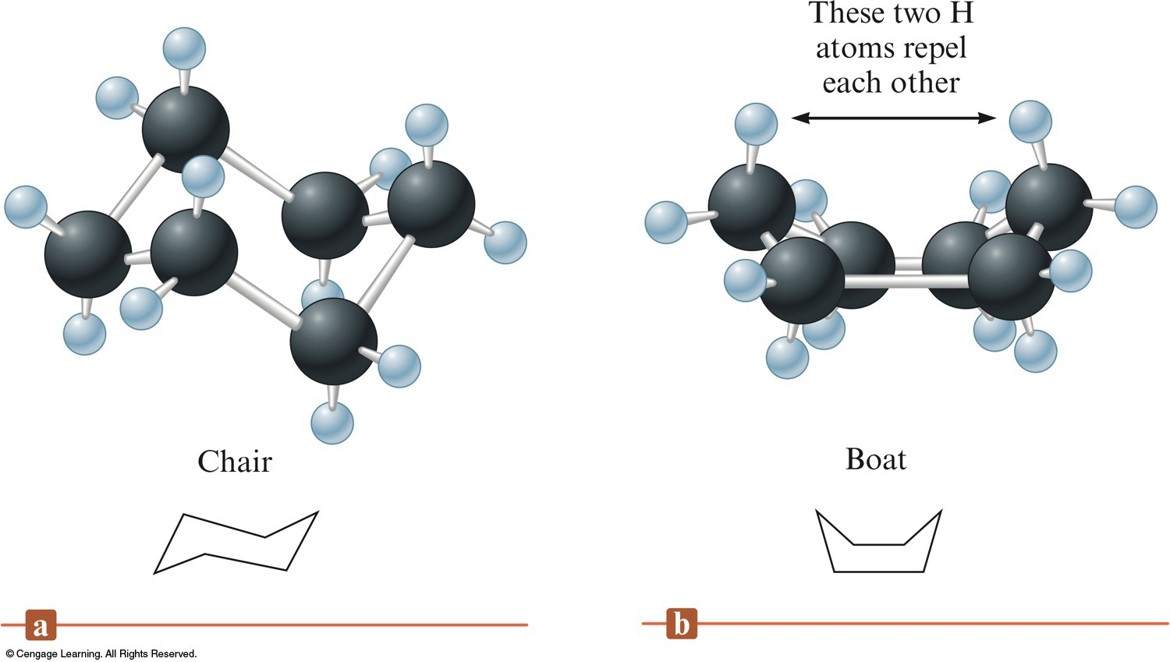
Hydrocarbons
- Alkenes: hydrocarbons that contain at least one carbon–carbon double bond. [\(\chem{C_nH_{2n}}\)]
- Alkynes: hydrocarbons containing at least one carbon–carbon triple bond. [\(\chem{C_nH_n}\)]
$$ \chem{CH_3–CH=CH_2}\;\;\;\;\text{propene} $$
$$ \chem{CH_3–CH_2–C\equiv C–CH_3}\;\;\;\;\text{2–pentyne} $$
Rules for Naming Alkenes
- Root hydrocarbon name ends in –ene. $$ \chem{C_2H_4}\text{ is ethene} $$
- With more than 3 carbons, double bond is indicated by the lowest–numbered carbon atom in the bond. $$ \chem{CH_2=CH–CH_2–CH_3}\text{ is 1-butene} $$
Rules for Naming Alkynes
- Same as for alkenes except use -yne as suffix $$ \begin{align} &\chem{CH_3-CH_2-C\equiv C-CH_2-CH_2-CH_2-CH_3} \\ &\text{3-octyne} \end{align} $$
Exercise
Name each of the following:
2,3,5-trimethyl-2-hexene
6-ethyl-3-methyl-3-octene
More Reactions
- Addition Reactions
- Pi bonds (which are weaker than the C-C bonds), are broken, and new \(\sigma\) bonds are formed to the \(\sigma\) atoms being added. $$ \chem{CH_2=CHCH_3 + H_2 \xrightarrow{catalyst} CH_3CH_2CH_3} $$
- Halogenation Reactions
- Addition of halogen atoms of alkenes and alkynes. $$ \chem{\underset{1-pentene}{CH_2=CHCH_2CH_2CH_3} + Br_2 \rightarrow \underset{1,2-dibromopentane}{CH_2BrCHBrCH_2CH_2CH_3}} $$
Aromatic Hydrocarbons
- A special class of cyclic unsaturated hydrocarbons.
- Simplest of these is benzene (\(\chem{C_6H_6}\)).
- The delocalization of the \(\pi\)-electrons makes the benzene ring behave differently from a typical unsaturated hydrocarbon.
Benzene (Aromatic Hydrocarbon)
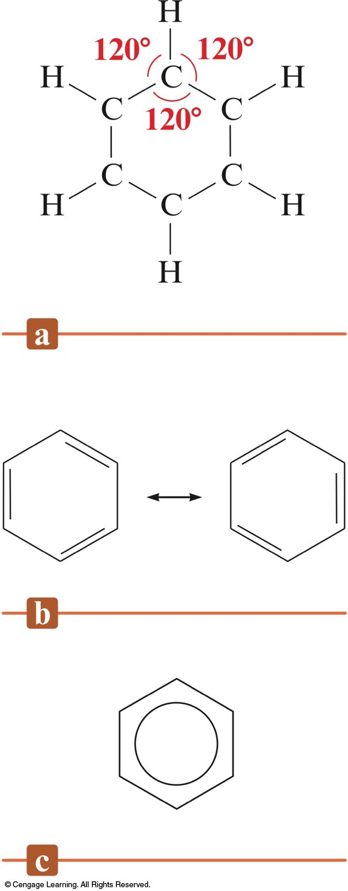
Aromatic Hydrocarbons Continued
- Unsaturated hydrocarbons generally undergo rapid addition reactions, but benzene does not.
- Benzene undergoes substitution reactions in which hydrogen atoms are replaced by other atoms.
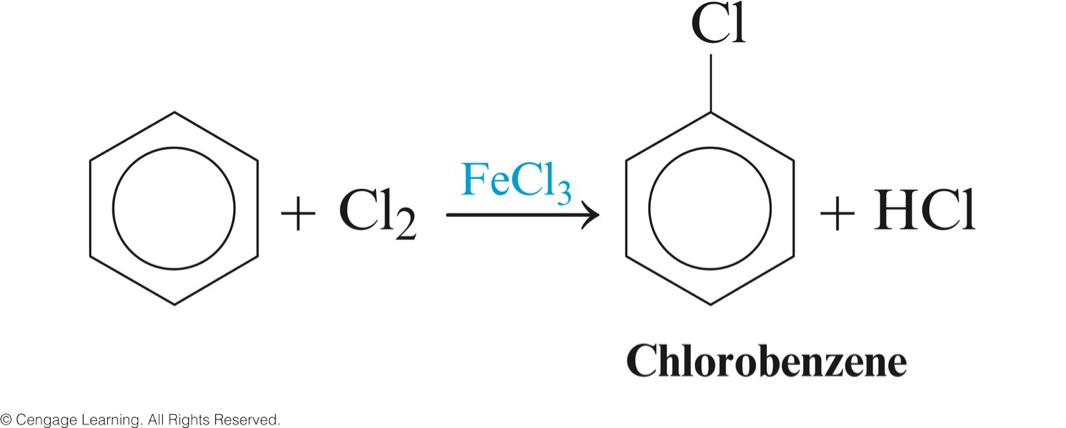
More Complexe Aromatic Systems
| Name | Use or Effect |
|---|---|
| Naphthalene | Formerly used in mothballs |
| Anthracene | Dyes |
| Phenanthrene | Dyes, explosives, and synthesis of drugs |
| 3,4-Benzpyrene | Active carcinogen found in smoke and smog |
Hydrocarbon Derivatives
- Molecules that are fundamentally hydrocarbons but have additional atoms or groups of atoms called functional groups.
The Common Functional Groups
| Class | Functional Group | General Formula | Example |
|---|---|---|---|
| Halohydrocarbons | \(\chem{-X}\text{ (F, Cl, Br, I)}\) | \(\chem{R-X}\) | \(\chem{CH_3I}\) iodomethane (methyl iodide) |
| Alcohols | \(\chem{-OHX}\) | \(\chem{R-OH}\) | \(\chem{CH_3OH}\) methanol (methyl alcohol) |
| Ethers | \(\chem{-O-}\) | \(\chem{R-O-R'}\) | \(\chem{CH_3OCH_3}\) dimethyl ether |
| Aldehydes | \(\begin{align} &\underset{||}{\chem{O}} \\ \chem{-}&\chem{C-H} \end{align}\) | \(\begin{align} &\underset{||}{\chem{O}} \\ \chem{R-}&\chem{C-H} \end{align}\) | \(\chem{CH_2O}\) methanal (formaldehyde) |
| Ketones | \(\begin{align} &\underset{||}{\chem{O}} \\ \chem{-}&\chem{C-} \end{align}\) | \(\begin{align} &\underset{||}{\chem{O}} \\ \chem{R-}&\chem{C-R'} \end{align}\) | \(\chem{CH_3COCH_3}\) propanone (dimethyl ketone or acetone) |
| Carboxylic acids | \(\begin{align} &\underset{||}{\chem{O}} \\ \chem{-}&\chem{C-OH} \end{align}\) | \(\begin{align} &\underset{||}{\chem{O}} \\ \chem{R-}&\chem{C-OH} \end{align}\) | \(\chem{CH_3COOH}\) ethanoic acid (acetic acid) |
| Esters | \(\begin{align} &\underset{||}{\chem{O}} \\ \chem{-}&\chem{C-O-} \end{align}\) | \(\begin{align} &\underset{||}{\chem{O}} \\ \chem{R-}&\chem{C-O-R'} \end{align}\) | \(\chem{CH_3COOCH_2CH_3}\) ethyl acetate |
| Amines | \(\chem{-NH_2}\) | \(\chem{R-NH_2}\) | \(\chem{CH_3NH_2}\) aminomethane (methylamine) |
Polymers
- Large, usually chainlike molecules that are built from small molecules called monomers.
Common Synthetic Polymers and Their Monomers and Applications
| Monomer | Polymer | |||
|---|---|---|---|---|
| Name | Formula | Name | Formula | Uses |
| Ethylene |  |
Polyethylene |  |
Plastic piping, bottles, electrical insulation, toys |
| Propylene | 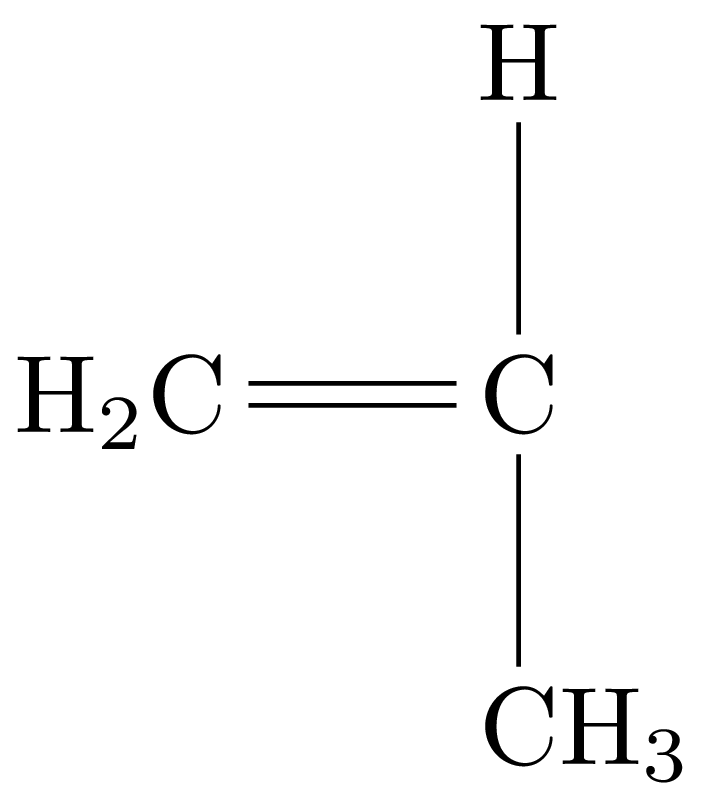 |
Polypropylene |  |
Film for packaging, carpets, lab wares, toys |
| Vinyl chloride | 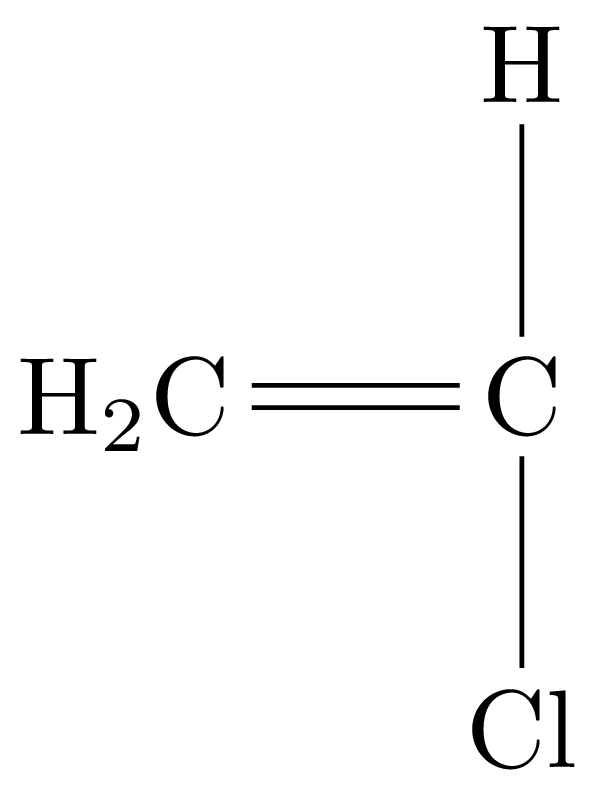 |
Polyvinyl chloride (PVC) | 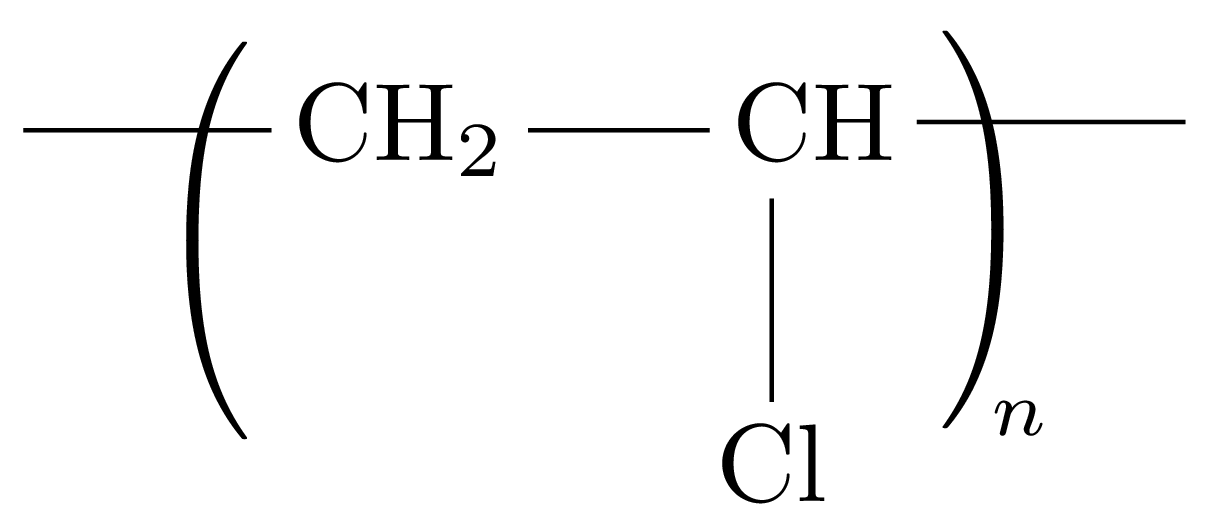 |
Piping, siding, floor tile, clothing, toys |
More Common Synthetic Polymers and Their Monomers and Applications
| Monomer | Polymer | |||
|---|---|---|---|---|
| Name | Formula | Name | Formula | Uses |
| Acrylonitrile | 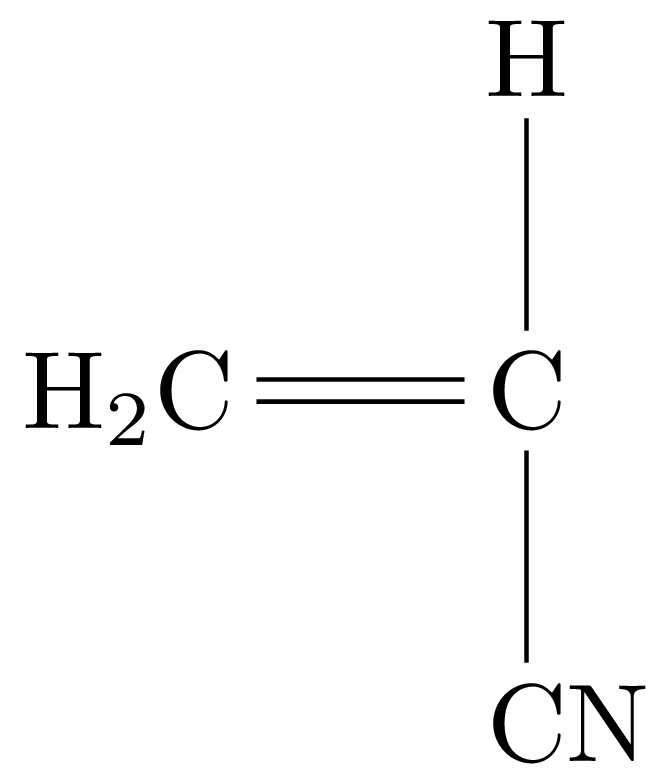 |
Polyacrylonitrile (PAN) |  |
Carpets, fabrics |
| Tetrafluoroethylene |  |
Teflon |  |
Cooking utensils, electrical insulation, bearings |
Even More Common Synthetic Polymers and Their Monomers and Applications
| Monomer | Polymer | |||
|---|---|---|---|---|
| Name | Formula | Name | Formula | Uses |
| Styrene |  |
Polystyrene | 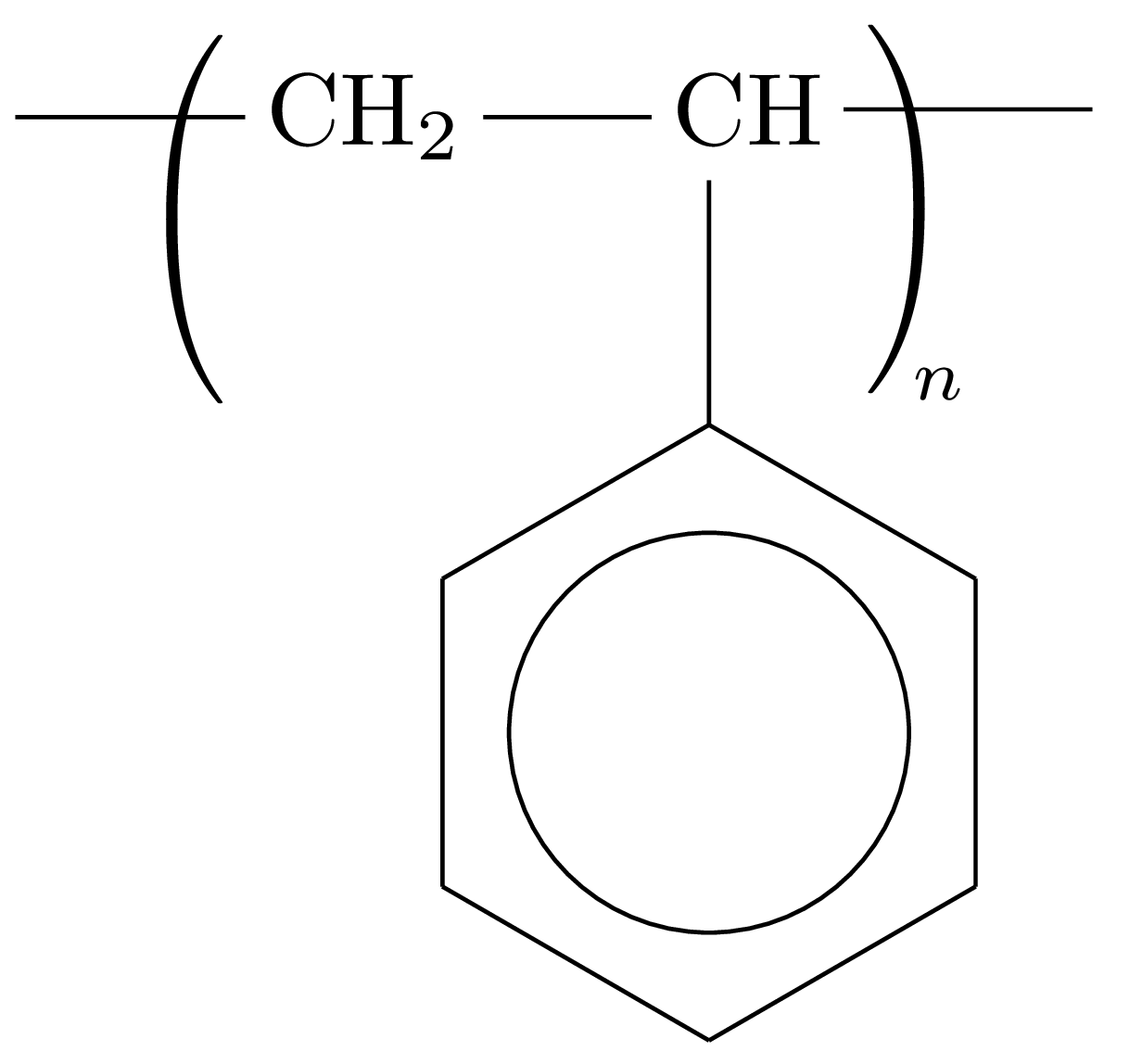 |
Containers, thermal insulation, toys |
| Butadiene | 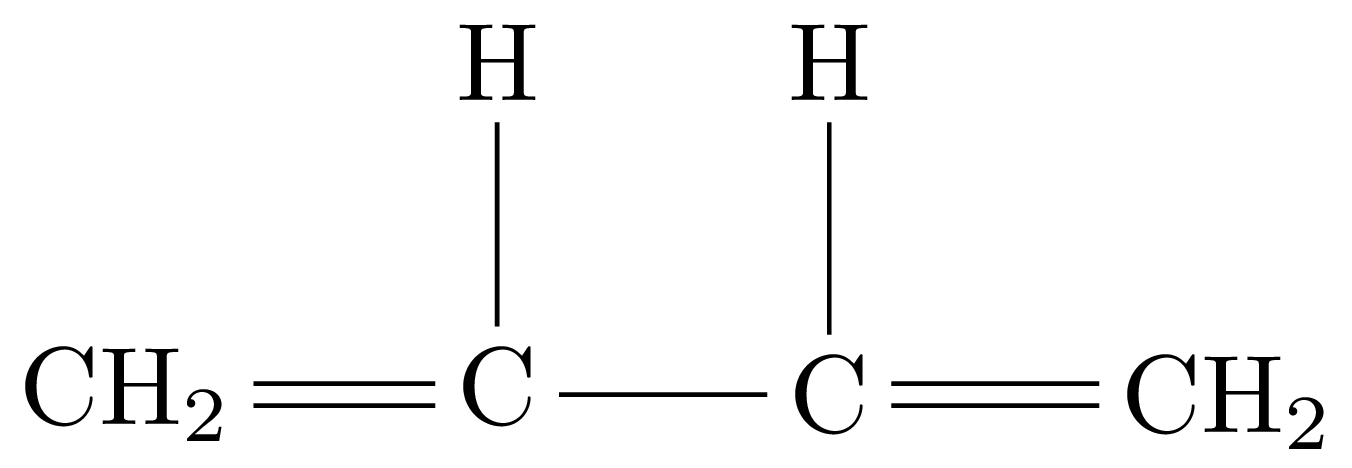 |
Polybutadiene |  |
Tire tread, coating resin |
| Butadiene and styrene | See previous entries. | Styrene-butadiene rubber | 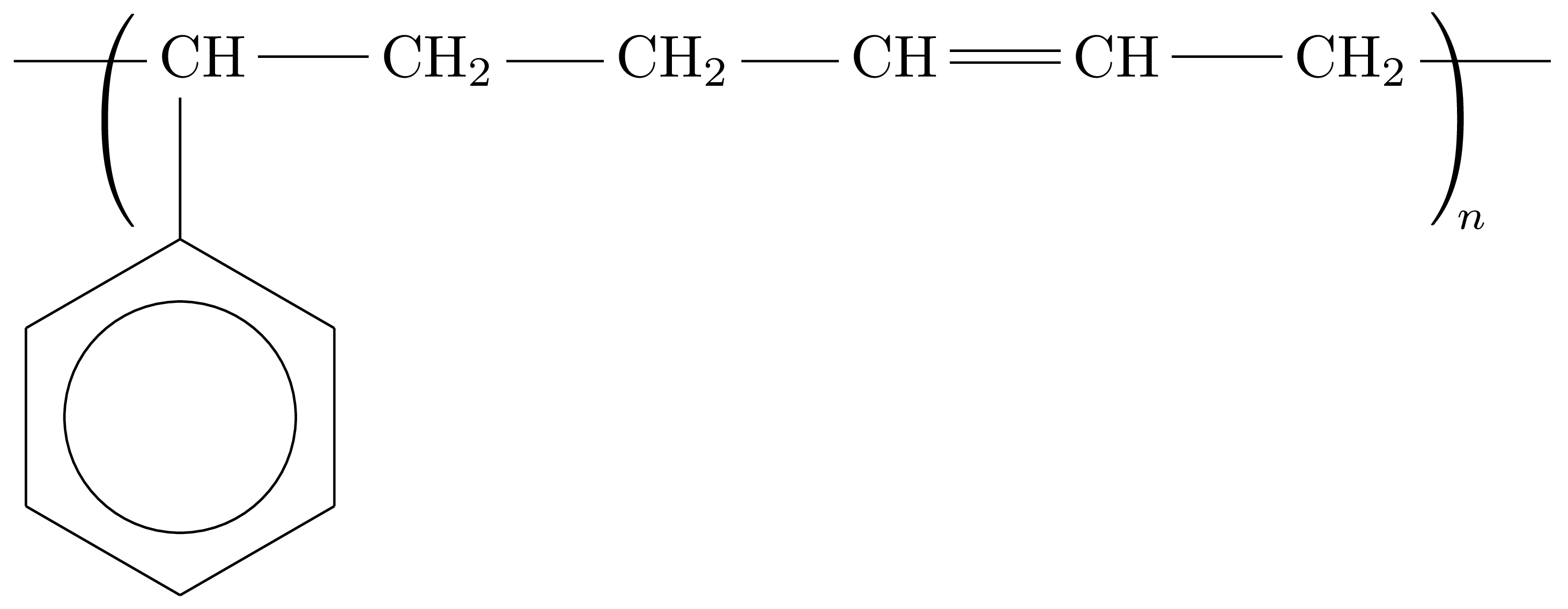 |
Synthetic rubber |
Types of Polymerication
- Addition Polymerization
- Monomers "add together" to form the polymer, with no other products. (Teflon)
- Condensation Polymerization
- A small molecule, such as water, is formed for each extension of the polymer chain. (Nylon)
Proteins
- Natural polymers made up of \(\alpha\)-amino acids with molar masses: $$ \sim 6000\text{ to } > 1,000,000\,\bfrac{\mathrm{g}}{\mathrm{mol}} $$
- Fibrous Proteins: provide structural integrity and strength to muscle, hair and cartilage.
- Globular Proteins:
- Roughly spherical shape
- Transport and store oxygen and nutrients
- Act as catalysts
- Fight invasion by foreign objects
- Participate in the body’s regulatory system
- Transport electrons in metabolism
\(\alpha\)-Amino Acids
- \(\chem{–NH_2}\) always attached to the \(\alpha\)-carbon (the carbon attached to \(\chem{–COOH}\)) $$ \begin{align} &\chem{\underset{|}{H}} \\ \chem{H_2N-}&\chem{C-COOH} \\ &\chem{\overset{|}{R}} \end{align} $$ where R is a side chain
Bonding in \(\alpha\)-Amino Acids
- There are 20 amino acids commonly found in proteins.

Levels of Structure in Proteins
- Primary: Sequence of amino acids in the protein chain.
- Secondary: The arrangement of the protein chain in the long molecule (hydrogen bonding determines this).
- Tertiary: The overall shape of the protein (determined by hydrogen-bonding, dipole-dipole interactions, ionic bonds, covalent bonds and London forces).
Hydrogen Bonding in \(\alpha\)-Helical Arrangement of a Protein Chain
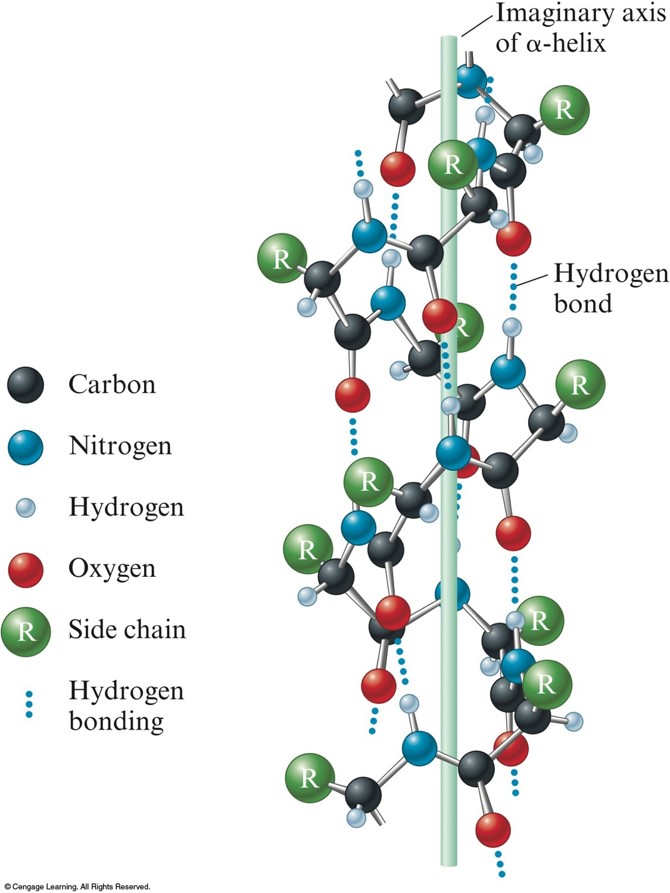
Pleated Sheet
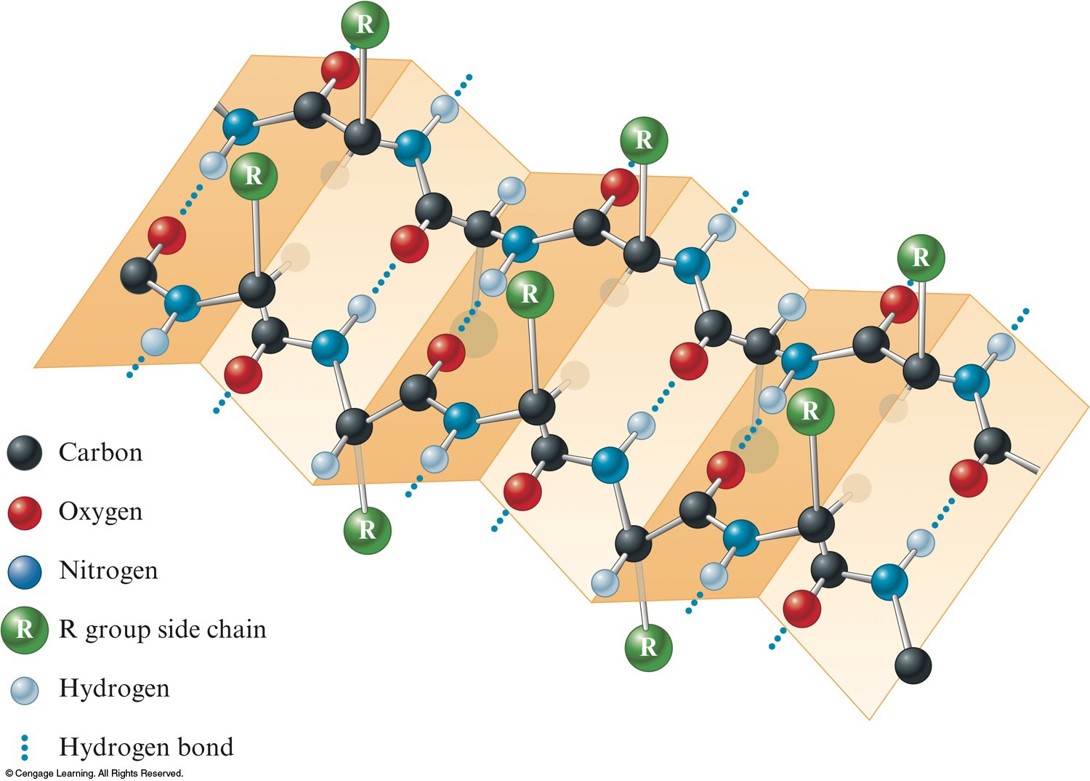
Carbohydrates
- Food source for most organisms and structural material for plants.
- Empirical formula = \(\chem{CH_2O}\)
- Monosaccharides (simple sugars)
- pentoses – ribose, arabinose
- hexoses – fructose, glucose
Some Important Monosaccharides
- D-Ribose
- D-Arabinose
- D-Ribulose
- D-glucose
- D-Monnose
- D-Galactose
- D-Fructose
Carbohydrates
- Disaccharides (formed from 2 monosaccharides joined by a glycoside linkage, a \(\chem{C—O—C}\) bond between the rings):
- Polysaccharides (many monosaccharide units):
sucrose (glucose + fructose)
starch, cellulose
The Disaccharide Sucrose is Formed From α-D-glucose and Fructose

Nucleic Acids
- DNA (deoxyribonucleic acid): stores and transmits genetic information, responsible (with RNA) for protein synthesis.
- RNA (ribonucleic acid): helps in protein synthesis.
(Molar masses = several billion)
(Molar masses from 20,000 to 40,000 g/mol)
Nucleotides
- Monomers of the nucleic acids.
- Three distinct parts:
- A five–carbon sugar, deoxyribose in DNA and ribose in RNA.
- A nitrogen–containing organic base.
- A phosphoric acid molecule (\(\chem{H_3PO_4}\)).
Deoxyribose (in DNA) and Ribose (in RNA)
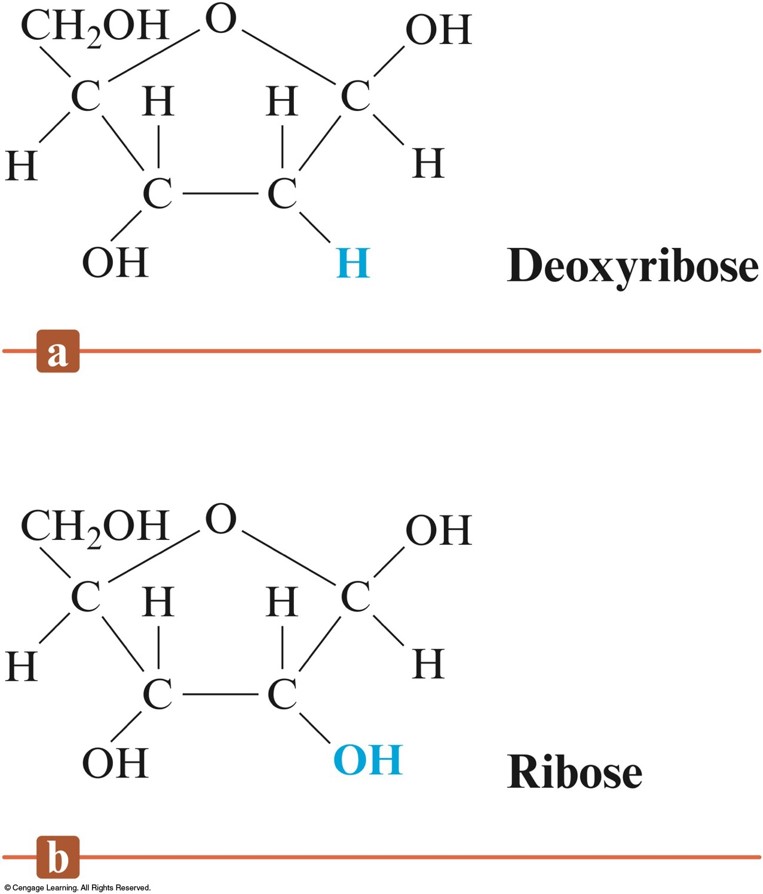
The Organic Bases Found in DNA and RNA
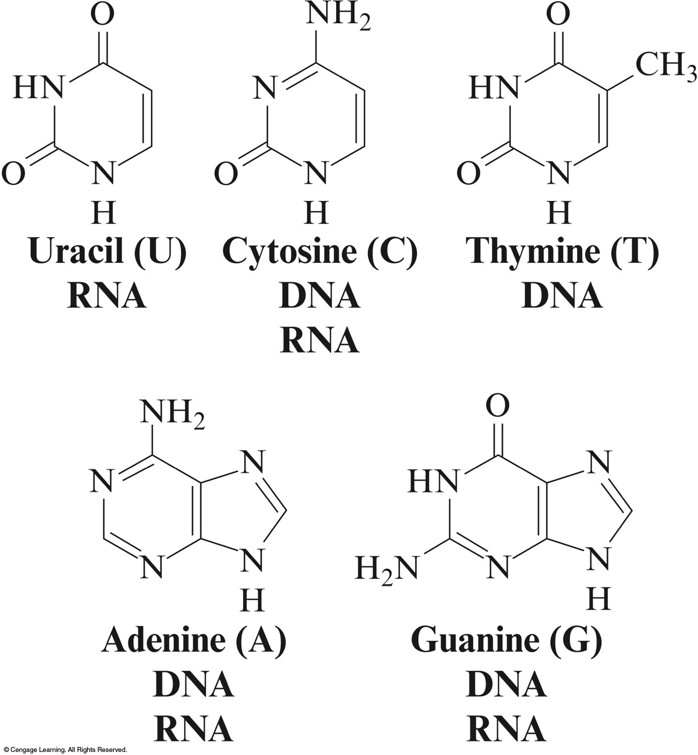
DNA
- Key to DNA’s functioning is its double-helical structure with complementary bases on the two strands.
- The bases form hydrogen bonds to each other.
Hydrogen Bonding in DNA
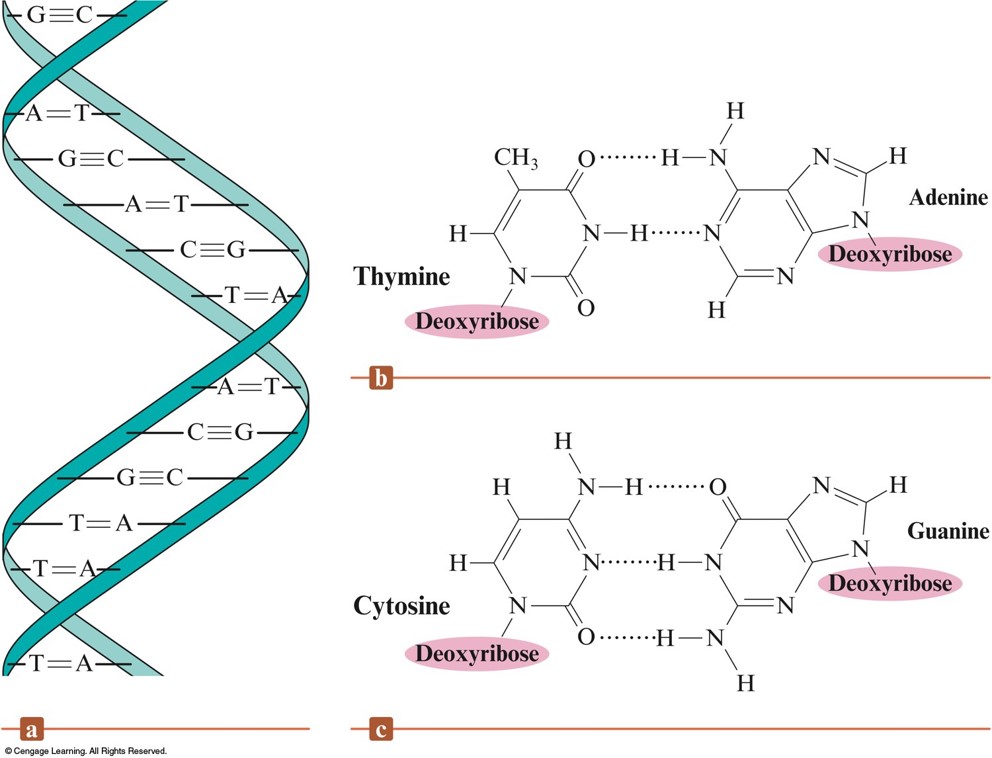
/



